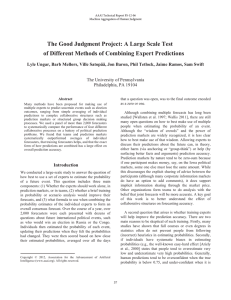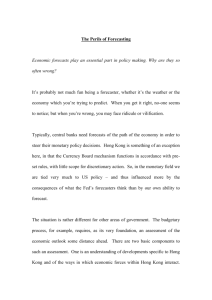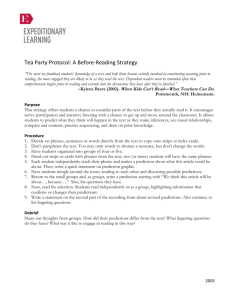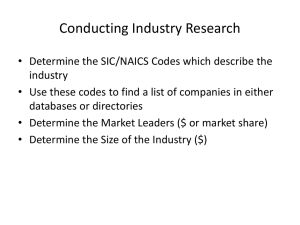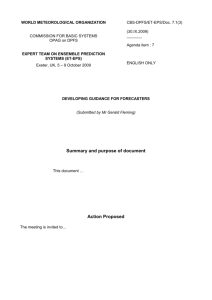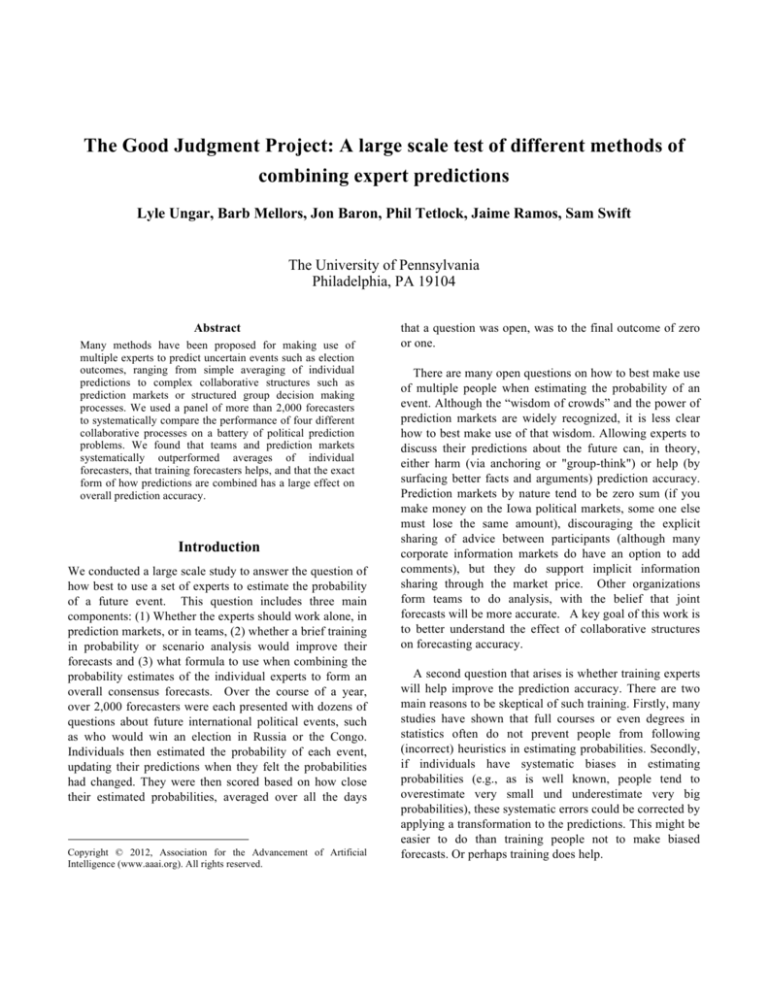
The Good Judgment Project: A large scale test of different methods of
combining expert predictions
Lyle Ungar, Barb Mellors, Jon Baron, Phil Tetlock, Jaime Ramos, Sam Swift
The University of Pennsylvania
Philadelphia, PA 19104
Abstract
Many methods have been proposed for making use of
multiple experts to predict uncertain events such as election
outcomes, ranging from simple averaging of individual
predictions to complex collaborative structures such as
prediction markets or structured group decision making
processes. We used a panel of more than 2,000 forecasters
to systematically compare the performance of four different
collaborative processes on a battery of political prediction
problems. We found that teams and prediction markets
systematically outperformed averages of individual
forecasters, that training forecasters helps, and that the exact
form of how predictions are combined has a large effect on
overall prediction accuracy.
Introduction
We conducted a large scale study to answer the question of
how best to use a set of experts to estimate the probability
of a future event. This question includes three main
components: (1) Whether the experts should work alone, in
prediction markets, or in teams, (2) whether a brief training
in probability or scenario analysis would improve their
forecasts and (3) what formula to use when combining the
probability estimates of the individual experts to form an
overall consensus forecasts. Over the course of a year,
over 2,000 forecasters were each presented with dozens of
questions about future international political events, such
as who would win an election in Russia or the Congo.
Individuals then estimated the probability of each event,
updating their predictions when they felt the probabilities
had changed. They were then scored based on how close
their estimated probabilities, averaged over all the days
Copyright © 2012, Association for the Advancement of Artificial
Intelligence (www.aaai.org). All rights reserved.
that a question was open, was to the final outcome of zero
or one.
There are many open questions on how to best make use
of multiple people when estimating the probability of an
event. Although the “wisdom of crowds” and the power of
prediction markets are widely recognized, it is less clear
how to best make use of that wisdom. Allowing experts to
discuss their predictions about the future can, in theory,
either harm (via anchoring or "group-think") or help (by
surfacing better facts and arguments) prediction accuracy.
Prediction markets by nature tend to be zero sum (if you
make money on the Iowa political markets, some one else
must lose the same amount), discouraging the explicit
sharing of advice between participants (although many
corporate information markets do have an option to add
comments), but they do support implicit information
sharing through the market price. Other organizations
form teams to do analysis, with the belief that joint
forecasts will be more accurate. A key goal of this work is
to better understand the effect of collaborative structures
on forecasting accuracy.
A second question that arises is whether training experts
will help improve the prediction accuracy. There are two
main reasons to be skeptical of such training. Firstly, many
studies have shown that full courses or even degrees in
statistics often do not prevent people from following
(incorrect) heuristics in estimating probabilities. Secondly,
if individuals have systematic biases in estimating
probabilities (e.g., as is well known, people tend to
overestimate very small und underestimate very big
probabilities), these systematic errors could be corrected by
applying a transformation to the predictions. This might be
easier to do than training people not to make biased
forecasts. Or perhaps training does help.
Finally, given a set of individual probability estimates,
we want to know how to combine them to get a single
overall forecast. Here, too, controversy reigns. Although it
is appealing to use some sort of weighting when combining
the forecasts that gives more weight to forecasters with
more expertise, there have been many studies showing that
it is extremely hard to beat a uniform average of individual
forecasts This has long been known [Clemen 1989], and
recent work has only extending this to averaging different
sources such as prediction markets as well as individuals
[Graefe et al 2011] However, although the vast majority of
people aggregating forecasters use a linear combination of
the individual probability estimates, theory shows that no
such linear combination can be optimal. [Ranjan and
Gneiting, 2010].
Methodology
We recruited over 2,000 forecasters ranging from graduate
students to forecasting and political science faculty and
practitioners (average age 35) and collected a wide variety
of demographic and psychographic data on them including
IQ and personality tests. Each forecaster was randomly
assigned to one of three trainings (none, probability, and
scenario training) and to one of four different modes of
information sharing (individual predictions in isolation,
individual predictions seeing what others predict, a
prediction market, and team predictions).
Predictions were evaluated using the Brier score [Brier
1950]: The sum of squared differences between the
estimated probability and the actual (0 or 1) outcome.
Brier scores for each problem on each day were averaged
over all of the days the problem was open, and then the
scores for all the problems were averaged. 1 Individuals or,
in the team setting, teams were encouraged to minimize
their Brier score. No financial reward was given, but there
was a “Leader board” making public the most successful
people.
Aggregation methods
We compared a variety of aggregation methods, looking at
combinations of different
(1) weightings of forecasters based on their personality
and expertise attributes, averaged either using a weighted
mean or a weighted median.
1
This gives equal weight to each problem, and not to each
day the problem was open. One could argue for the other
weighting, but it is attractive to consider each problem as a
separate, independent, observation.
(2) down-weightings of older forecasts using
exponential decay and
(4) transformations of the aggregated forecasts to push
them away from 0.5 to more extreme values.
Selecting the right combinations of parameters across
these cases is a complex non-linear joint optimization
procedure; fortunately, the results are not highly sensitive
to the exact parameters used, and hence the results are
robust to the optimization details.
Of these, the most import and least obvious is the
transformation of the aggregate forecasts. Note that we
take the weighted mean first, and then transform; this
works much better than transforming first and then
averaging the transformed individual predictions. The
a
a
1/a
transformation we used is: p /(p +(1-p)) with a=3.
Results
We found that strong forecasters make more predictions,
have greater political knowledge, and get higher scores on
a variety of tests: the Raven’s IQ test, a cognitive reflection
test, and a numeracy test.
Recall that we randomly assigned forecasters to one of 12
conditions based on a 3 x 4 factorial design of Training by
Elicitation. Levels of training included No Training,
Probability Training, and Scenario Training, and levels of
elicitation were Control (independent forecasters), Crowd
Beliefs (independent forecasters who saw the distribution
of forecasts for others in their group but are unable to
communicate, and Teams (forecasters who worked in
groups of 15-20 and were asked to justify the basis of their
forecasts to each other).
Figure 2 summarizes the effects results for the conditions
other than the prediction markets. The probability and
scenario trainings both produced significant improvements
in performance. In contrast to what one might expect from
anchoring theory, letting forecasters see results of others’
forecasts is beneficial, as is the prediction market (which
has a similar effect) The team condition was significantly
better than the other conditions, and still benefited from the
trainings. A key attribute of our team condition was that
team members were encouraged to share information with
each other, explaining why they made their predictions.
Note that our collaborations were all done in an
asynchronous online envirnment, thus reducing reducing
the infuence of senior or vocal team members; we have not
done a face-to-face control to see how significant this
effect is.
The aggregation methods used also had a large effect, as
shown in Figure 3. Of the three methods, using the results
of IQ, personality, knowledge and numeracy tests had the
smallest benefit. (This is good news, as such data are often
not available.) As time passes, the outcomes of most events
become more predictable. It is therefore important to
update probability estimates. We did this in the
aggregation method by using an exponential decay (a time
constant of a couple days was optimal in most of our tests),
so that out-of-date predictions counted less. (Just using the
current day’s forecasts can be problematic, as there may be
too few forecasters on a given day.) Most important was
the use of transformations to push the forecasts farther
away from 0.5
On the need for transformations
The benefit of transforming the aggregate predictions away
from 0.5 is striking, and merits some discussion. Some
intuition into this need comes by noting the nonlinear
effects that uncertainties have in probability space.
Assume an event that a knowledgeable person estimates
will occur with probability 0.9. Less knowledgeable
people will sometimes give a higher estimate, but they will
more often give lower estimates. The more ignorant I
think I am, the closer to 0.5 my estimate should be.
Averaging all of the individual probability estimates will
thus necessarily give a consensus estimate that is too close
to 0.5.
Any individual estimating the probability of an event has
both irreducible uncertainty, uncertainty shared by the
entire group, that no one can eliminate and personal
uncertainty, the extra uncertainty caused by each person's
specific personal ignorance. To better understand this,
note that having special expertise helps on some problems,
but not on others. For example, financial futures such as
currency exchange rates tend to have low personal
uncertainty experts can't on average do better than the
average reader of the Wall Street Journal. In contrast,
events which have already happened, or 'fixed' elections in
obscure countries have high personal uncertainty and lower
irreducible uncertainty; someone knows the answer, just
not most people.
When people with high personal uncertainty make
predictions, they should rationally make guesses that are
closer to 0.5 than forecasters with low personal
uncertainty. When estimates from a pool of forecasters are
averaged together, this causes the mean to be too close to
0.5.
There are several ways that one might try to account for
personal and irreducible uncertainty when pooling
probability estimates:
1) Ask people how uncertain they are, and use that
information to pick an ``optimal'' weight when combining
estimates. We found that although people have some idea
of when they have high personal uncertainty, they are
relatively poor at estimating their own knowledge (or
ignorance) relative to the rest of the prediction pool. The
benefit of using personal expertise ratings, at least in our
experiments on international political events, was
marginal.
2) Transform everyone's estimates away from 0.5 before
combining the estimates together. This can be done in a
principled way by assuming that people make estimates
that have Gaussian noise in the log-likelihood space, but it
works poorly in practice, in part because probability
estimates of zero or one lead to infinite log-likelihoods.
3) Take the median of the individual estimates. This is
easy, can be generalized to a weighted median for the case
that one weights forecasters based on their test scores, and
works well in practice. It relaxes the assumption of
Normality in log-likelihood space, and compensates for the
fact that noise in estimating probabilities must be highly
skewed (since variation around, e.g. p = 0.9 will mostly be
much lower probabilities and never be more than 0.1
higher).
4) Take the average (possibly using a weighting) all
predictions to get a single probability estimate, and then
transform this aggregate forecast away from 0.5, as
described above. We found this to reliably give the lowest
errors.
There is no reason to believe that the amount of
transformation which we used (a in the range of 3 to 4
gives the best results) is optimal on all problems. In fact, if
all individual forecasters give the same prediction, one
could argue that no transformation (a=1) is optimal. We
are studying the question of how much to transform for
different problems.
Conclusions
Our two main findings are:
(1) Working in groups greatly improves prediction
accuracy. In our study, a structured Internet collaboration
environment that allows forecasters to comment on each
others forecasts was the winner, beating out the prediction
market, but both significantly outperformed simply
aggregating predictions made by individuals working
alone.
(2) When combining predictions from multiple experts,
weighted averages perform far less well than
transformations of these weighted averages that shift the
combined forecast away from 0.5.
Transforming
individual forecasts and then averaging does not do nearly
as well, but taking the median of the individual forecasts is
a close second.
References
Brier, G. W. (1950). "Verification of forecasts expressed in terms
of probability" Monthly weather review 78: 1–3.
Clemen, RR (1989) Combining forecasts: A review and annotated
bibliography International Journal of Forecasting,
Graefe, A, JS Armstrong, R. Jones and A Cuzan (2011)
Combining forecasts: An application to election forecasts APSA
Annual Meeting, 2011
Ranjan, R. and Gneiting, T. (2010), Combining probability
forecasts. Journal of the Royal Statistical Society: Series B
(Statistical Methodology), 72: 71–91.
Yaniv, I. (1997). Weighting and trimming: Heuristics for
aggregating judgments under uncertainty.
Organizational
Behavior and Human Decision Processes, 69, 237-249.
0.4 Average Brier Score 0.35 0.3 0.25 0.2 0.15 Other Control TGJ Control Teams Prediction Teams Plus Markets Algorithms Figure 1. Summary of the largest effects on prediction error. The first column (“other
controls”) is a less good (or less involved) pool of forecasters, uniformly averaged. The second is our,
better, pool of forecasters, uniformly averaged. Putting our forecasters into teams gives a major
reduction in error over having forecasters work independently, but by itself does not doe as well as
prediction markets. However, when the team results are then weighted, given exponential decay, and
transformed away from 0.5, they give the best performance.
0.50 Average Brier Score 0.45 0.40 No Train Prob Train 0.35 Scen Train 0.30 0.25 Control Crowd Beliefs Team Figure 2. Effect of Probability and Scenario training.
Average Brier Score 0.35 Controls Crowd Beliefs Teams 0.31 0.27 0.23 0.19 0.15 Figure 3. Effect of different aggregation methods. For Controls (individual forecasts), Crowd beliefs
(shared knowledge individual forecasts) and Teams (Collaborative forecasts), we show the unweighted
mean, the effect of adding in our “individual difference (“In Diff”) test results to weight higher scoring
forecasters more highly, of adding in exponential decay of early forecasts (“Decay”), of transforming the
averaged forecast (“Trans”) and of doing “All Three” simultaneously.


